
Cartmel Priory church serves as the parish church of Cartmel, Cumbria, England.

Quedgeley is a town and civil parish in the city of Gloucester in Gloucestershire, England. A thin strip of land between the Severn and the Gloucester Ship Canal occupies the west, and the south-eastern part of the town is Kingsway Village, directly to the north of which is Tuffley.

St Mary's Church, Moseley is a Grade II listed parish church in the Church of England located in Moseley, Birmingham. It is now part of a united benefice with St Anne's Church, Moseley. The War Memorial in the South-East corner of the Churchyard, facing Oxford Road, is unusual in that it depicts Christ upon the cross in carved stone. The War Memorial has achieved its own Grade II listing.
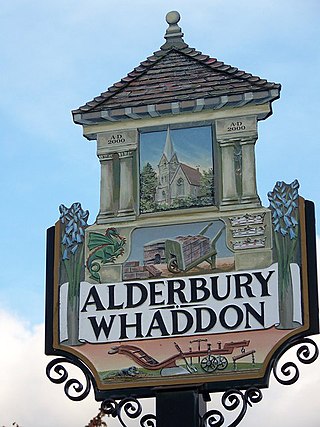
Alderbury is a village and civil parish in Wiltshire, England, in the south of the county around 3 miles (5 km) southeast of Salisbury.

Tuffley is a suburb in the city of Gloucester in Gloucestershire, England. The ward is unparished and situated near Robinswood Hill.

St Mary the Virgin is a 13th-century Anglican parish church in Northolt, London Borough of Ealing. It is on a slope shared with Belvue Park, the site of a 15th-century manor house — both overlooked the old village of Northolt. It is one of London's smallest churches, its nave measuring 15 yards (14 m) by 8 yards (7.3 m). The church was built around 1290 and was expanded over the centuries, with the chancel being added in 1521, the spired bell tower in the 16th century, and a gallery at the west end of the church in 1703. Twin buttresses were erected against the west wall around 1718 to alleviate concerns that the church could slip down the hill. The internal beams are original and the bells date from the 17th century. The church was constructed from a variety of materials; the nave incorporates clunch, flint and ironstone, and the mouldings of the doors and windows are made from Reigate Stone.
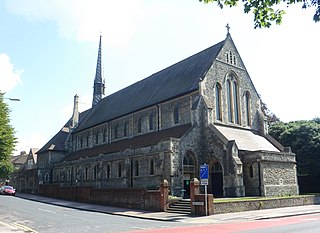
St John the Evangelist's Church is an Anglican church in the Preston Village area of Brighton, in the English city of Brighton and Hove. The Grade II listed building, designed by Sir Arthur Blomfield, was started in 1901 but did not take its present form for another quarter of a century. In the meantime, the nearby parish church of Preston was severely damaged by fire, and the new church was granted the parish church status which it still retains.
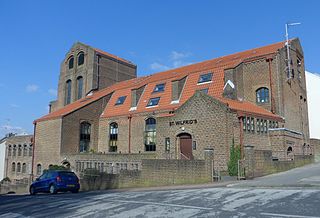
St Wilfrid's Church is a former Anglican church in the Elm Grove area of Brighton, part of the English city of Brighton and Hove. Designed and built in the 1930s to replace a temporary building in the densely populated Elm Grove area, its unusual design—not conforming with architectural norms of the era—was widely praised. It was declared redundant after less than 50 years as a place of worship, and was converted into sheltered housing with minimal alteration to the exterior. Shortly after its closure, it was granted Grade II listed status.

St Richard's Church is an Anglican church in the town of Haywards Heath in the district of Mid Sussex, one of seven local government districts in the English county of West Sussex. The present reinforced concrete and brick structure replaced a temporary building which was a daughter church to Haywards Heath's parish church, St Wilfrid's; the new church soon became parished in its own right to reflect the rapid population growth in the northern part of the town. English Heritage has listed the 1930s building at Grade II for its architectural and historical importance.
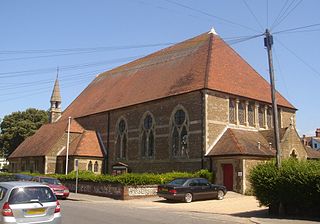
St George's Church is an Anglican church in the East Worthing area of the borough of Worthing, one of seven local government districts in the English county of West Sussex. Built in 1867–68 to serve new residential development in the southeast of the town, the Decorated Gothic-style structure was extended later in the 19th century, and expanded its reach further by founding three mission halls elsewhere in Worthing. English Heritage has listed it at Grade C for its architectural and historical importance.

St Andrew the Apostle is an Anglican church in Worthing, West Sussex, England. Built between 1885 and 1886 in the Early English Gothic style by Sir Arthur Blomfield, "one of the last great Gothic revivalists", the church was embroiled in controversy as soon as it was founded. During a period of religious unrest in the town, theological tensions within Anglicanism between High church Anglo-Catholics and Low church Anglicans were inflamed by what the latter group saw as the church's "idolatrous" Roman Catholic-style fittings—in particular, a statue of the Virgin Mary which was seized upon by opponents as an example of a reversion to Catholic-style worship in the Church of England. The "Worthing Madonna" dispute delayed the consecration of the church by several years. English Heritage has listed the building at Grade C for its architectural and historical importance, and the adjacent vestry and vicarage are listed separately at Grade II.

St Luke's Church is a United Reformed church in the Silverhill suburb of Hastings, a town and borough in East Sussex, England. The congregation was originally independent before taking up Presbyterianism, and worshipped in a private house from its founding in 1853 until a permanent church was provided in 1857; this was one of the oldest Presbyterian places of worship in southeast England. The growth of the community has resulted in several extensions since then, and severe damage caused by the Great Storm of 1987 was quickly repaired—except for the loss of the building's distinctive spire. The church, along with most other Presbyterian congregations, joined the United Reformed Church when that denomination was formed in 1972. It is one of four United Reformed Churches in the borough of Hastings.

St Peter's Church is a former Anglican church in the Bohemia area of the town and seaside resort of St Leonards-on-Sea, part of the Borough of Hastings in East Sussex, England. Founded in 1883 in response to the rapid residential growth of this part of St Leonards-on-Sea, the "outstanding late Victorian church" was completed and opened in 1885. Architect James Brooks was towards the end of his career but still produced a successful, powerful Gothic Revival design, which was built by prolific local firm John Howell & Son—builders of several other churches in the area.

St Stephen's Church, Gloucester Road, is a Grade II* listed Anglican church located on the corner of Gloucester Road and Southwell Gardens in South Kensington, London, England.
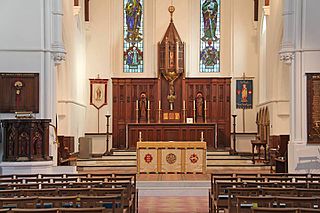
The Parish Church of Saint Paul is a Church of England parish church in New Southgate, London Borough of Enfield, London. St Paul's is an inclusive, welcoming church with an all-age community. Service details are available on the church's website: https://stpaulsnewsouthgate.co.uk/. Baptisms, Weddings and Funerals are regularly taken at St Paul's.
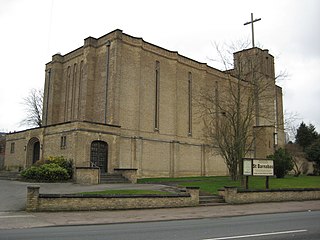
St Barnabas Church is a Grade II listed building located in Stroud Road, Gloucester, Gloucestershire, England. It was built in 1938–40 and obtained its Grade II status on 9 March 1982. The church's denomination is the Church of England.

Aldborough Hatch is an area in Ilford in east London, England, within the London Borough of Redbridge. It is located 11.1 miles (18 km) east-northeast of Charing Cross. It is a semi-rural locality situated to the east of Barkingside and Newbury Park.

St Paul and St Stephen Church is a Church of England church located in Stroud Road, Gloucester, Gloucestershire. St Paul church was built between 1882 and 1883. St Stephen church was built between 1898 and 1900. St Stephen church was closed in 2010 and the church was merged with St Paul's which became St Paul and St Stephen church. Closely associated with the church is St Paul's Church of England Primary school located in New Street, Gloucester which opened in 1870.
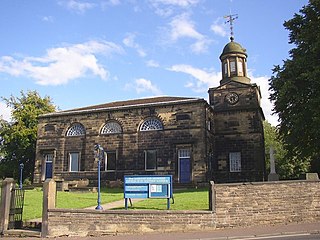
St Matthew's Church is a local ecumenical partnership church building situated on Church Street in Rastrick, West Yorkshire, England. The present church was built in 1798 and is a Grade II* listed building. It is shared by the Church of England and the Methodist Church of Great Britain.
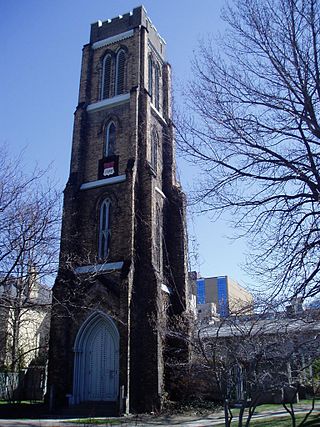
St. George by the Grange Anglican Church, formerly known as St. George the Martyr Anglican Church, is an Anglican Church of Canada church in the Grange Park neighbourhood of Toronto, Ontario. The church is currently in a period of "sabbath rest" from public worship.




















